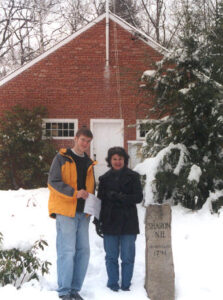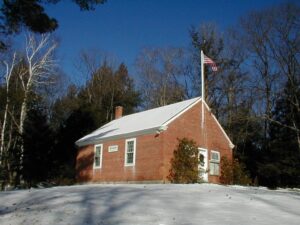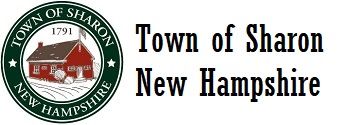The following article appeared in local newspapers in January, 2002.

Being one of the smallest towns in the Monadnock Region (population: 375+-) is not Sharon’s only claim to fame. The town’s one-room Brick Schoolhouse, in constant use since it was built in 1832, was recently awarded listing on the New Hampshire State Register of Historic Places. The State Register was established approximately a year ago and the Sharon Brick Schoolhouse is currently one of only six places on the statewide list.
“The Brick Schoolhouse in Sharon is a perfect example of the type of property we are hoping to list on the new State Register of Historic Places,” says Elizabeth Muzzey, State Survey Coordinator for the New Hampshire Division of Historical Resources. “It has been used and appreciated for almost 170 years and that obviously means a great deal to the town’s residents. Sharon is fortunate to have such a well-preserved and intact historical resource.”
Today [2002], the Brick Schoolhouse is used regularly for weekly town clerk’s hours and as a meeting place for the Sharon Selectmen, Planning Board and Conservation Commission. The structure has served various public town functions including that of town meeting hall, polling booth and repository of town records. It marks the de facto center of Sharon and historians have, in fact, referred to this section of town as “Sharon City.”
Still in its original location, the one-story brick building measures just 26 x 30 feet. As was typical of other small schoolhouses of the time, the school was sited on a small knoll with its door in the gable end and was situated to overlook what was, even in the 1830s, the main road in Sharon (currently Route 123). It was used as a public school for nearly nine decades, from 1833 to 1920. During that time, the student population fluctuated from a high of around 40 students to a low of around 10 students. Intermittently in the 1800s, the Schoolhouse was also used for Baptist and Congregational church services.
In 1920, the population of Sharon fell to below 50 and the townspeople decided to send their children to Peterborough for public education because it was too costly to educate the dwindling number of students in town.
The exterior appearance of the Brick Schoolhouse has changed little in the nearly 170 years since it was built. Minor alterations to update its systems (heat and electricity) and to add other modern conveniences (larger windows, a flag pole) have not changed the original design of the building. Externally, the brickwork is in good condition and internally, the original pine floors and wide-pine wainscoting remain along with five rows of pine and wrought-iron desks with chairs.
Other one-room brick schoolhouses in the area are located in Peterborough, New Ipswich, and Hancock.
The New Hampshire State Register of Historic Places application was completed by Sharon resident and writer Tina Rapp, who volunteered her time. She was assisted by members of the Sharon Conservation Commission. Extensive research for the application was accomplished by ConVal High School student Taylor Shipman of Hancock, who earned ½ credit for completion of the work as a Civic Action Project during the spring 2001 semester. Currently a senior with a special interest in history, Shipman enjoyed the process of working hands-on with primary source material to learn more about the history of the schoolhouse and the town. “Much of world history is reflected in local history,” says Shipman. “And this was a really worthwhile project that supplemented my work in the classroom.”
Members of the Sharon Conservation Commission are hopeful that the Brick Schoolhouse will qualify for the National Register of Historic Places, and an application is in process.
[End of Article]For Immediate Release
March 3, 2003
Sharon Brick Schoolhouse Joins Three Other Monadnock Region Schoolhouses on the National Historic Register
Sharon’s one-room Brick Schoolhouse is keeping good company. It was recently awarded a listing on the National Register of Historic places, joining three other listed schoolhouses in the Monadnock Region. Those schools include the High Tops School in Westmoreland, the Nelson Schoolhouse, and the Richmond Schoolhouse No.6.

The schoolhouse received its award for being associated with events that have made a significant contribution to the broad patterns of our history, which is on one of four possible criteria for National Register listings. It is well-preserved and has changed little over the years. Of the three one-room schools that served the town of Sharon, it is the only one still in existence.
The building has been in constant use since it was constructed in 1832. “There’s a lot of history in our schoolhouse,” said Chet Bowles, Sharon Selectmen Chair. “It’s seen its share of school children, voters, town meetings and town government activities, and it will continue to serve our town’s needs in the future.”
The Town of Sharon recently developed a task force to research improvements to the building, including handicapped access, expanded office space and plumbing. The plan will be presented to voters at the 2004 Town Meeting. According to Christine Fonda, National Register Coordinator for the New Hampshire Division of Historical Resources, the listing does not impose any restrictions or limitations on the use of this property unless federal funds are involved.
Known through the years by several names including the East School, the Center School, the District Two Schoolhouse and even the School of the Middle Class, this was the only one-room schoolhouse in Sharon, NH made of brick. Because two previous wood frame and clapboard schoolhouses had been erected in District Two and destroyed by fire, in 1799 and 1832 respectively, the town chose to construct this particular schoolhouse out of brick for its permanence.
A new site was selected for the Brick Schoolhouse on the other side of Street Road (known today as Route 123) from where the two previous District Two schoolhouses had stood, and was constructed at a total expenditure of $300.
The Brick Schoolhouse was in use as a public school for nearly nine decades, from 1833 to 1920. During that time, the student population fluctuated from a high of around 40 students to a low of around 10 students. Of the three one-room schoolhouses in Sharon, NH, the Brick Schoolhouse appears to have had the largest student population through the years, holding both a winter session that lasted about 10 weeks and a summer session that lasted about 12 weeks. As was common for the time, a lone teacher was responsible for instructing up to 40 students from first through eighth grade.
Since Sharon schoolchildren began attending Peterborough schools in the 1920s, the schoolhouse has served various public town functions including that of town meeting hall, polling booth and repository of town records. Today, the Brick Schoolhouse is used regularly for weekly town clerk’s hours and as a meeting place for the Sharon Selectmen, Planning Board and Conservation Commission. Other one-room brick schoolhouses in the area are located in Peterborough, New Ipswich, and Hancock.
The National Register of Historic Places application was completed by Sharon residents Liz LaRose, Tina Rapp, Gina Goff, and Rory Goff and Con-Val student Taylor Shipman, who all donated their time.
